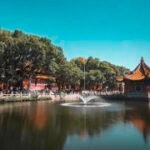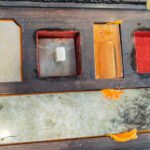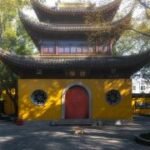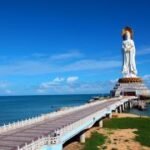Huiji Temple is located on Foding Mountain at a high place on Mount Putuo. It is also known as Foding Mountain Temple and is one of the three major temples on Mount Putuo. What is famous here is the Zhusheng Empress in the Guanyin Hall. It is said to be a very effective Guanyin who bestows children. In addition, due to its location on the top of the mountain, a platform in front of the temple is a good place to watch the sunrise and sunset. The architecture of Huiji Temple is unique. It is built along the mountain and arranged horizontally. The halls are spacious and magnificent, hidden deep in the forest, and are known for their quiet environment. There are a total of 145 rooms in the entire temple, including 4 halls, 7 halls, 5 attics, and storehouses. The layout of the temple is adapted to the mountain. The Mahavira Hall, the Great Compassion Hall, the Sutra Depository, the Jade Emperor Hall, and the abbot’s room are all on the same parallel line and embrace the left and right wing rooms, quite similar to the garden architecture style of eastern Zhejiang. If you have good physical strength, you can choose to hike up the mountain. Walk up along the stone slab road with lotus embedded in the yellow walled passage. Along the way, you can see many devout believers kowtowing three times and making nine prostrations there, murmuring words. Of course, you can also choose to take the cable car up the mountain and walk down, which saves physical strength. Walking down all the way along Xiangyun Road is Fayu Temple. Along the way, you can also see the huge rock of ‘Buddha Kingdom on the Sea and Sky’. When the weather is good, you can see clouds surrounding the mountainside. When visiting Huiji Temple, you can take photos at several small landscapes such as the lotus pond, the ‘Buddha on the top of Buddha’ wall, and the stone tablet of ‘Reaching the Other Shore Together’. Other than that, the Mahavira Hall and the Guanyin Hall are relatively prosperous in incense offerings. Different from other temples on Mount Putuo, in the main hall, the Mahavira Hall, enshrines the statue of Sakyamuni Buddha, with disciples Ananda and Kassapa standing on both sides. There are ten statues on each side of the hall, which are the ‘twenty heavens’ in Buddhist legends. The roof of the Mahavira Hall is entirely covered with glazed tiles of different colors. If you take the cable car up the mountain, you may see the magnificent landscape of ‘Buddha’s light shining everywhere’ in the sunlight. On the left side of the Mahavira Hall is the Guanyin Hall. Inside the hall are stone carvings of Guanyin engraved according to the Guanyin images painted by generations of painters. It is one of the essences of religious art on Mount Putuo. Of course, this is also a place that many people who come to Mount Putuo to pray for fertility must visit. It is said to be very effective. When burning incense here, you must be sincere. Three sticks of incense are enough. However, making noise, smoking, taking photos, and lighting incense candles are strictly prohibited inside the hall. After worshipping the Buddha, you can go and take a look at the ‘Putuo hornbeam’ at the back door of Huiji Temple. This tree was brought by Burmese monks when they came to worship on Mount Putuo more than 200 years ago. It is currently listed as a national second-class tree species and is also a landscape that many tourists will come to view.
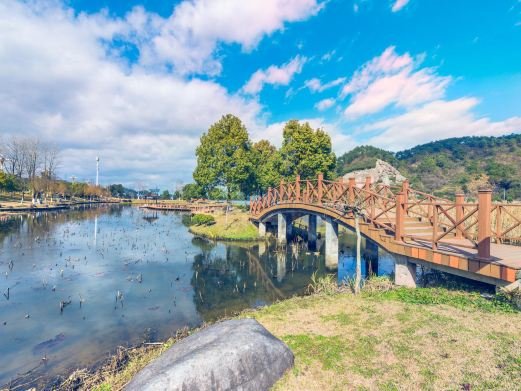
Opening hours: Open all year round from 05:20 to 17:30.
Minors aged 6 to 18 years old (inclusive) or with a height of 5 meters (inclusive), holding valid certificates, enjoy preferential treatment. Elderly people: Elderly people aged 70 years old and above (inclusive) across the country, holding valid certificates, are free. Elderly people aged 60 to 69 years old (inclusive), holding valid certificates, enjoy preferential treatment. Students: Full-time students of ordinary schools (excluding evening universities, TV universities, online education, distance education, adult education, continuing education, and full-time off-campus education), holding valid certificates, enjoy preferential treatment. Disabled people: Holding valid certificates, are free. Military personnel: Active-duty military personnel across the country, including armed police and disabled soldiers, holding valid certificates, are free. Journalists: Holding press cards issued by the General Administration of Press and Publication, are free. Teaching staff: Only on Teacher’s Day, holding valid certificates, are free. Tour guides: Holding national tour guide certificates, are free. Monks and nuns: Holding valid certificates, are free. National model workers: Holding valid certificates, are free. National moral models: Holding valid certificates, are free. Retired cadres: Holding valid certificates, are free. Families of martyrs: Holding valid certificates, are free. Supplementary note: 1. People who meet the reduction or exemption conditions please hold their valid certificates and go through the ticket check to enter the mountain. 2. The ticket for Putuo Mountain scenic area does not include the incense ticket for temples and the ticket for Luojia Mountain scenic spot. 3. The above information is for reference only. For specific information, please refer to the disclosure on the day of Putuo Mountain scenic area.
Must-see tips: 1. If you want to walk up the mountain, it is recommended to wear comfortable shoes. 2. Try to avoid visiting during holidays, the Guanyin incense fair period, Guanyin Nirvana Day and the first day of the lunar month of each month, because there will be a lot of people at that time.

